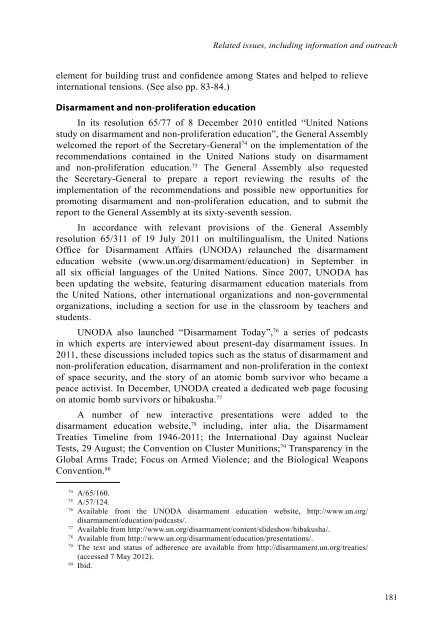DYB2011-Part-II-web
DYB2011-Part-II-web
DYB2011-Part-II-web
You also want an ePaper? Increase the reach of your titles
YUMPU automatically turns print PDFs into web optimized ePapers that Google loves.
Related issues, including information and outreach<br />
element for building trust and confidence among States and helped to relieve<br />
international tensions. (See also pp. 83-84.)<br />
Disarmament and non-proliferation education<br />
In its resolution 65/77 of 8 December 2010 entitled “United Nations<br />
study on disarmament and non-proliferation education”, the General Assembly<br />
welcomed the report of the Secretary-General74 on the implementation of the<br />
recommendations contained in the United Nations study on disarmament<br />
and non-proliferation education. 75 The General Assembly also requested<br />
the Secretary-General to prepare a report reviewing the results of the<br />
implementation of the recommendations and possible new opportunities for<br />
promoting disarmament and non-proliferation education, and to submit the<br />
report to the General Assembly at its sixty-seventh session.<br />
In accordance with relevant provisions of the General Assembly<br />
resolution 65/311 of 19 July 2011 on multilingualism, the United Nations<br />
Office for Disarmament Affairs (UNODA) relaunched the disarmament<br />
education <strong>web</strong>site (www.un.org/disarmament/education) in September in<br />
all six official languages of the United Nations. Since 2007, UNODA has<br />
been updating the <strong>web</strong>site, featuring disarmament education materials from<br />
the United Nations, other international organizations and non-governmental<br />
organizations, including a section for use in the classroom by teachers and<br />
students.<br />
UNODA also launched “Disarmament Today”, 76 a series of podcasts<br />
in which experts are interviewed about present-day disarmament issues. In<br />
2011, these discussions included topics such as the status of disarmament and<br />
non-proliferation education, disarmament and non-proliferation in the context<br />
of space security, and the story of an atomic bomb survivor who became a<br />
peace activist. In December, UNODA created a dedicated <strong>web</strong> page focusing<br />
on atomic bomb survivors or hibakusha. 77<br />
A number of new interactive presentations were added to the<br />
disarmament education <strong>web</strong>site, 78 including, inter alia, the Disarmament<br />
Treaties Timeline from 1946-2011; the International Day against Nuclear<br />
Tests, 29 August; the Convention on Cluster Munitions; 79 Transparency in the<br />
Global Arms Trade; Focus on Armed Violence; and the Biological Weapons<br />
Convention. 80<br />
74 A/65/160.<br />
75 A/57/124.<br />
76 Available from the UNODA disarmament education <strong>web</strong>site, http://www.un.org/<br />
disarmament/education/podcasts/.<br />
77 Available from http://www.un.org/disarmament/content/slideshow/hibakusha/.<br />
78 Available from http://www.un.org/disarmament/education/presentations/.<br />
79 The text and status of adherence are available from http://disarmament.un.org/treaties/<br />
(accessed 7 May 2012).<br />
80 Ibid.<br />
181


